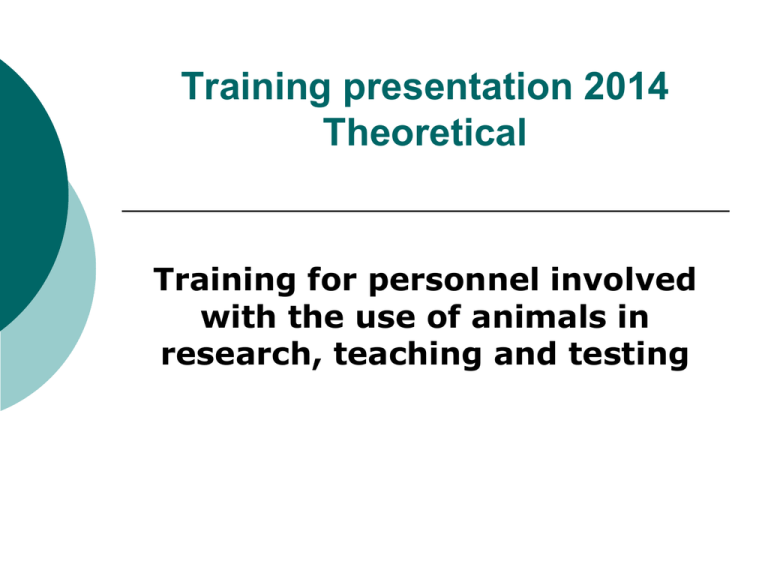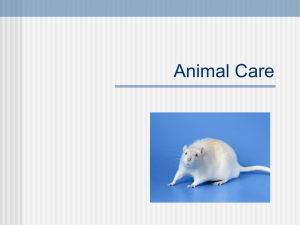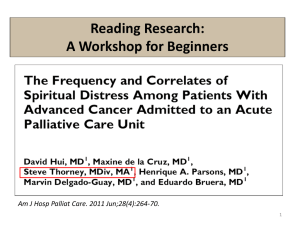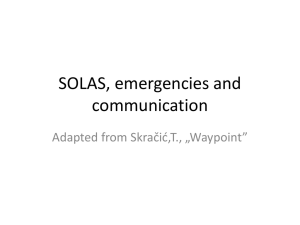Training for personnel involved with the use of animals in research
advertisement

Training presentation 2014 Theoretical Training for personnel involved with the use of animals in research, teaching and testing The Responsibility for the Well - being of Animals Used in Research Good science requires good animal care. Animals that are in poor condition, discomfort or pain are poor research subjects. Animal well-being supports the integrity of the research. Guide for the Care and Use of Laboratory Animals From National Research Council. Provides information that will enhance animal wellbeing, the quality of biomedical research, and the advancement of biologic knowledge that is relevant to humans or animals. The AUB Faculty of Medicine has established in 2003 an “Institutional Animal Care and Use Committee” IACUC. The aim of the IACUC is to make sure that laboratory animals used in research, teaching, testing and training at AUB are treated in accordance with the “US Government Principles for the Utilization and Care of Vertebrate Animals used in Testing, Research and Training”. 4 The IACUC is responsible for: (1) Overseeing the use and care of animals at the American University of Beirut Faculty of Medicine (AUB-FM) and for (2) Reviewing of research and teaching activities involving animals conducted on AUB-FM premises by faculty, students and staff. 5 Abdo Jurjus, Ph.D., Professor, Anatomy, Cell Biology and Physiology, Chairman. Ali Bazarbachi, M.D., Ph.D., Professor and Associate Dean for Basic Research- Faculty of Medicine (ex-officio). Laura Dosh, Officer (ex-officio). Fouad Farhat, D.V.M, Veterinarian. Asad Zeidan, Ph.D., Professor, Anatomy, Cell Biology and Physiology. George Nemer, Ph.D., Associate Professor, Department of Biochemistry and Genetics. Hiba El-Hajj, Ph.D., Assistant professor, Department of Internal Medicine. Hala Ghali-Muhtasib, Professor, Department of Biology Robert Habib, Ph.D., Associate Professor, Department of Internal Medicine. Raya Saab, M.D., Assistant Professor, Department of Pediatrics and Adolescent Medicine. Said Saghieh, M.D., Assistant Professor of Clinical Surgery. Siham Radi, Community Representative; Non-Scientific Concerns; Not Affiliated with AUB. 6 The IACUC must review all activities involving the care and use of animals in research or teaching. (The USDA Animal Welfare Act requires that the IACUC perform the same duties for all activities involving animals covered by the Act, regardless of funding source.) All new proposals for animal use and significant changes to existing proposals for animal use must be reviewed and approved by the IACUC before animal use can begin. No animals may be used for experimental procedures, including field studies, pilot studies, breeding, or euthanasia for sample collection without receiving prior IACUC approval. 7 Review and approve, require modification in, or withhold approval to, proposals for research and teaching that require the use of animals. Review and approve, require modification in, or withhold approval to, changes regarding the use of animals in ongoing, previously approved, activities. Suspend any activity that is not in compliance with the policies and guidelines that govern the use and care of animals at AUB-FM. Inspect the institutional animal care facilities at least once every 6 months. 8 Review the Animal Care Program for the humane care and use of animals at AUB-FM at least once every 6 months. Submit reports to the Dean or designated institutional official on the review and inspection processes at least once every six months. Make written recommendations relating to the Animal Care Program, animal care facilities and related personnel or programs. Review concerns involving the care and use of animals at the AUB-FM. 9 The IACUC must have oversight of all areas where animal procedures are performed and may determine the appropriate interval for inspection of procedural spaces: a. This includes spaces in research laboratories where routine procedures are performed b. This includes any non-surgical procedures, such as weighing, blood collection, euthanasia. The IACUC must inspect surgical records, drug records, and experimental records as appropriate to monitor for protocol adherence. 10 There are two valid methods of animal proposal review by the IACUC i. Full committee review by a convened quorum of the IACUC. This can be an in person meeting, or a real time meeting by teleconference, video conference, etc. ii. Designated review by one or more members of the committee only after all voting members have been provided the opportunity to review the proposal and call for full committee review. 11 After review of animal proposals, the IACUC may take one of the following actions i. Approve as written ii. Require modifications to protocol to secure approval iii. Disapprove the proposal. 12 The Animal Use Form If the scientist plans to use animals as part of the research, he or she must explain in an Animal Use Form WHY animals are needed to accomplish the aims, What procedures will be performed on the animals and How the animals will be housed and cared for throughout the project. Description of the pain category for the research animals (Pain category C, D or F). CATEGORIES OF INVASIVENESS IN ANIMAL EXPERIMENTS “PAIN CATEGORIES” Pain Category C Type of Experiments / Procedures Experiments / Procedures causing little discomfort or stress D Experiments / Procedures causing moderate to severe distress or pain using anesthesia and / or painkiller E Experiments / Procedures causing prolonged or severe clinical distress or pain without the use of anesthesia and / or painkiller Pain Category C Category C procedures include: Experiments causing minor stress of short duration Level C procedures should not cause significant changes in the animal’s appearance, Category C procedures include: Injection of material in amounts that will not cause adverse reactions Acute non-survival studies in which the animals are completely anaesthetized and do not regain consciousness Approved methods of euthanasia following rapid unconsciousness Short periods of food and/or water deprivation equivalent to periods of abstinence in nature Cannulation or catheterization of blood vessels or body cavities under anesthesia Minor surgical procedures under anesthesia- biopsies, laparoscopy Short periods of skillful restraint beyond that for simple observation or examination Blood sampling Pain Category D Category D procedures include: Experiments causing moderate to severe distress or pain using anesthesia and / or painkiller Level D procedures should not cause prolonged or severe clinical distress Category D procedures include: Major surgical procedures conducted under anesthesia with subsequent recovery Prolonged (several hours or more) periods of physical restraint Induction of behavioral stress - like maternal deprivation, aggression, predator-prey interactions Procedures causing severe, persistent or irreversible disruption of sensorimotor organization Pain Category E Category E procedures include: Experiments causing prolonged or severe clinical distress and / or pain without the use anesthesia and / or painkiller Procedures inflicting severe pain near, at, or above the pain tolerance threshold of not anesthetized, conscious animals Not confined to surgical procedures, but may include exposure to noxious agents or those having unknown effects Exposure to drugs or chemicals at levels that may impair physiological systems and cause death, severe pain, or extreme distress New biomedical experiments having a high degree of invasiveness Behavioral studies having unknown degree of distress Muscle relaxant or paralytic drug use without anesthetics Burn or trauma infliction on not anesthetized animals Toxicity testing and experimentally-induced infectious disease studies that have death as the endpoint Pain definition The American Academy of Pain Medicine defines pain as: “An unpleasant sensation (that can range from mild, localized discomfort to agony) and emotional response to that sensation”. Distress definition (Merriam – Webster) Synonyms: distress, suffering, misery, agony meaning the state of being in great trouble. Distress implies an external and usually temporary cause of great physical or mental strain and stress Suffering involves conscious endurance of pain or distress Misery stresses the unhappiness, poverty Agony means intense feelings of suffering; acute mental or physical pain; Assessment of pain or distress may be based on many different criteria Decreased activity Abnormal postures, hunched back, muscle flaccidity or rigidity Poor grooming Decreased food or water consumption Decreased fecal or urine output Weight loss (generally 20-25% of baseline), failure to grow, or loss of body condition (cachexia) Dehydration Decrease or increase in body temperature Decrease or increase in pulse or respiratory rate Physical response when touched (withdrawal, lameness, abnormal aggression, vocalizing, abdominal splinting, increase in pulse or respiration) Teeth grinding Self-aggression Inflammation Photophobia Vomiting or diarrhea Objective criteria of organ failure demonstrated by: hematological or blood chemistry values, imaging, biopsy, or gross dysfunction Ethical Considerations An important ethical principle of animal use in biomedical research is that alternatives to live animals should be used whenever possible. Documentation of a search for alternatives and an explanation for why these alternatives were not found to be suitable or how alternatives were incorporated into the experimental design is a mandatory requirement. Exploring alternatives to animal use may be accomplished by using the three Rs; Replacement, Reduction, and Refinement 21 The Three Rs - Replacement - Reduction - Refinement Replacement alternatives Replacing “higher” animals with “lower” animals. Microorganisms, plants, eggs, reptiles, amphibians, and invertebrates may be used in some studies to replace warm-blooded animals. Alternatively, live animals may be replaced with non-animal models such as: Dummies for an introduction to dissection for teaching the structure of the animal Mechanical or computer models Audiovisual aids In vitro modeling Reduction alternatives Minimizing the number of animals needed to perform an experiment or teach a concept, using replacement whenever possible. Methods to achieve this may include: Performing pilot studies to determine some of the potential problems in an experiment before numerous animals are used Gathering a maximum amount of information from each animal, perhaps gathering data for more than one experiment concurrently Consulting with a statistician to use only the numbers of animals required to achieve significance Minimizing variables such as disease, stress, diet, genetics, etc., that may affect experimental results Performing appropriate literature searches and consulting with colleagues to ensure that experiments are not duplicated Using the appropriate species of animal so that useful data are collected Refinement alternatives Refining experimental protocols to minimize pain or distress whenever possible. Examples of refinement may include: Using proper handling techniques and receiving adequate training prior to performing a procedure Ensuring that: – Procedures to be performed on the animal are reasonable for that species – Drug doses are correct and that the drugs used are not expired Identifying pain and distress and making plans for preventing or relieving it using appropriate analgesics and anesthetics for potentially painful procedures Refinement alternatives Performing: – Surgeries and procedures aseptically to prevent infection – Appropriate post-surgical care, including thermoregulation and fluid balance – Only one single major survival surgery procedure on any one animal, whenever possible Setting the earliest possible endpoint for an experiment. Explanation: If the necessary information can be gathered before the animal experiences prolonged suffering from the experimental procedure, this should be defined as the endpoint and the animal subsequently euthanized. Research Animals Rats and mice are good research models Rats and mice Are Handy, easy to care for and handle, and are inexpensive. Are small in size which means they can be housed in large numbers. Have short generation time and high reproductive potential which contribute to their usefulness in genetics research and to the economy of their production. Are amenable to germfree and pathogen-free production techniques The rat's age in human years Rat's age in months Rat's age in years 1.5 months (puberty) 6 months (social maturity) 12 months 18 months 24 months 30 months 36 months 42 months 45 months 48 months 0.125 years 0.5 years 1 year 1.5 years 2 years 2.5 years 3 years 3.5 years 3.75 years 4 years Rat's age in human years 12.5 years (puberty) 18 years (social maturity) 30 years 45 years 60 years 75 years 90 years 105 years 113 years 120 years SPECIAL BIOLOGY OF RODENTS Highly adaptable animals Nocturnal (active at night) Social animals, like to live in groups Aggression among adult male mice Sensitive to ultra sound Omnivorous, generally feeding ad libitum Animal Models MOUSE and RAT PHYSIOLOGY, NORMAL VALUES Respiration rate: Heart rate: Body temperature: Adult weight: Feed intake: Water intake: Urine output: Breeding age: Estrous cycle: Weight at birth: Gestation period: Weaning age: Blood pressure: Blood volume: Hematocrit: Mice 100 – 200 / min 300 – 800 / min 36, 5 – 38, 0 °C 20 – 40 g 3 – 6 g / day 4 – 7 ml / day 1 – 3 ml /day 8 – 10 weeks 4 days 0, 5 – 1, 5 g 18 – 21 days 21 days p.p. 147 / 106 mm Hg 2.4 ml (30g) 39 – 49 % Rats 70 – 110 / min 300 – 500 / min 37, 5 – 38, 5 °C 250 – 300 g 12 – 20 g 15 – 35 ml / day 10 – 15 ml / day 12 – 16 week 4 – 5 days ≈5g 21 – 23 days 21 days p.p. 145 / 105 mm Hg 18 ml (250 g) 36 – 48 % RODENT HUSBANDRY Suitable cages for mice( 4 mice in a 200 cm², 20 mice in a 810 cm²) special approval for use of wire mesh cages Bedding: shavings, (nesting material, environmental enrichment) Optimal temperature: 20 – 24 °C Optimal humidity: 50 – 60 % Air changes: 15 /hour Light cycle (12h / 12 h) Handling, examination, and restraint techniques Secure animal by holding it by the base of the tail. Remove animal from the cage Place animal on arm or table. Clinical examination: Eye discharge (porphyrin), Nose discharge Hair coat, parasites Body orifices – discharge, diarrhea Restraint techniques: Restrainer, Fixation grips Loose Restrain for IP and SC Injection Secure Restrain for IP and SC Injection ANIMAL IDENTIFICATION Short term (days) : - permanent marker Medium term (weeks) : - hair colors Long term (life) : - ear punch - toe amputation (newborns only!) - ear tags - tattoo on hairless skin - micro chip transponder Performing a Clinical Exam 1. Observation a. Observations without disturbing the animal: Activity level (hypoactivity, hyperactivity, restlessness, lack of inquisitiveness) Attitude (arousal, depression, awareness of surroundings) Spontaneous Behavior (vocalization, self-trauma, isolation from cage mates). b. Observations after disturbing the animal: Provoked Behavior (vocalization, hiding, aggressiveness, minimal response). 1. Observation of Animal Behavior and Appearance c. Other observations: Body condition Food and fluid intake Fur and skin (greasy or dull fur; cyanotic, pale, or congested mucous membranes or skin lesions; Eyes (porphyrin Posture (hunched back, tucked abdomen, head tucked down) staining) Locomotion (way of walking, ataxia, lameness, action of each limb, position of tail when ambulating, tremor, convulsion, circling, paralysis, head tilt) Vital signs (respiratory distress - e.g. open mouth breathing, pronounced chest movement) Other clinical parameters that are relevant to your study (presence and status of tumors, infection, or surgical wounds ) 2. Quantifiable characteristics of clinical parameters can be tracked over time compared to a starting baseline or to normal, untreated control animals Quantifiable characteristics of clinical parameters are: Body weight Hydration status Body temperature Behavior Surface lesions Blood parameters Specific Examination Procedures depending on research procedures 1. Body Weight Body weight changes are a sensitive indicator of rodent health A baseline weight measurement allows monitoring the impact of the experiment on the animal. Reduction in body weight may reflect starvation and / or dehydration Failure of young animals to gain weight is equivalent to a loss of body weight. Most rodents used in research are still growing. Therefore, body weight changes should be interpreted in terms of both : actual loss of weight and lack of expected growth 2. Hydration Status Observe the animals’ behavior. Assess the animals’ appearance: Skin turgor, hair coat, eye clarity, 3. Body Temperature_________________________ Due to their large ratio of body surface area to mass and high metabolic rate, rodents lose body warmth faster than do larger animals. A mouse can lose 1 degree of body temperature per 5 minutes. Body temperature measurements are also used for monitoring of humane endpoints. How often the animals should be monitored ? depends on: The severity of the animals' condition, The expected rate of change in the animals' status, and The impact of the procedure on the animals. The animals should be monitored at least once a day. But some situations require hourly observation. Methods for minimizing pain and distress in rodents Alleviation of Pain ad Distress When animals are found to be in pain or distress, The veterinarian and the investigator should be contacted . Decide on a treatment Treatment may include the administration of analgesics, antibiotics, warmth, fluid therapy, nutritional supplements, etc. Methods for minimizing pain and distress in rodents Nutritional Support Special Diets are: Commercial rodent surgical recovery diets; Surgical Transgel® (Charles River Laboratories). Peanut butter or jelly – mixtures to stimulate appetite and to increase food intake in cases of a) b) c) Reduced food (and water) intake 1-2 days post surgery For animals that are experiencing pain and distress Any study in which morbidity and reduced food intake occurs Methods for minimizing pain and distress in rodents Treatment of Imbalance of Fluids and Electrol Lactated Ringers Solution, 0.9% Saline, Glucose-saline Inject prior to a study and continue once daily Therapeutic fluids should be warmed prior to injection Analgesic treatments may be combined with daily fluid administrations Inject mouse s.c.: 3 ml/25 g rat s.c.: 15 ml/ 250 g Methods for minimizing pain and distress in rodents Temperature support There are many practical ways to provide temperature support to rodents, either individually or in cages. Warming pads: - Chemical warming pads (often too hot) - Circulating water warming pads Heat - Electrical heating pads (use discouraged) lamps (use discouraged) Keep animals warm until their activity has returned to normal If recovering animals are warmed within a cage, offer an area device. for escape from the heating Caution! Warming devices should provide gentle heat only (maximum of 40°C). Methods for minimizing pain and distress in rodents Alleviation of Pain ad Distress Pain Treatment Commonly used analgesics are: Ketoprofen Tramal Carprofen (lasts 24 hours) Flunixine Tylenol derivatives Conduct a pilot study to determine whether the analgesic may affect the study or not, Reassess the animal for pain as the analgesic effect wanes. Perform a clinical exam for signs of pain to determine if another dose is needed. Refer to the veterinarian for treatment recommendations. Documentation of health monitoring for rodents Documentation of Post-Procedure Care Record System 1. Cage identification system 2. Health record ( documenting the clinical observations and physical exam findings) Rodent health monitoring sheet PI: IACUC protocol: Experimental Procedure: Date of Experimental Procedure Date Animal/Group ID Body Condition Posture Mobility Responsiveness Haircoat Breathing Eyes and Nose Injection/Incision site Comments Immediate Euthanasia Criteria: Lethargy or non-responsiveness Ataxia or circling Labored breathing Uncontrolled bleeding or discharge from injection/incision site Emaciation or significant loss of body condition (greater than 20% loss of normal body weight) Significant pain or pain that does not respond to appropriate treatment Document all observations on the experimental health monitoring sheet. Alert the Attending Veterinarian of any ill or injured animals. Initials Humane Endpoint A Humane Endpoint can be defined as the point at which an experimental animal's pain and/or distress is terminated, minimized or reduced, by taking action such as euthanize the animal humanely, terminating a painful procedure, or giving treatment to relieve pain and/or distress. Unless otherwise approved by the IACUC, animals should be treated or euthanized before they become moribund or die due to tumor load. Endpoint in Cancer Research In cancer research animals should be euthanized before the tumor mass becomes excessive, ulcerates, or impairs the animal's bodily functions or behavior The criteria for endpoints in tumor development should be established in the animal protocol (scoring system): Tumor mass or burden Body condition, e.g. cachexia Impairment of body functions, e.g. way of walking Ulceration E. Summary Good science requires good animal care. Animals that are in poor condition, discomfort or pain are poor research subjects. Animal well-being supports the integrity of the research. In studies where animal morbidity is an expected outcome of the procedure humane experimental endpoints should be established that do not conflict with the scientific objectives. The strategies for assessing animal well-being and pain or distress are guidelines that can assist you in developing animal assessment methods that are appropriate for your experimental procedures. Alleviation of pain and distress in animals is not achieved solely by the use of analgesics. Experimental procedures offer many opportunities for enhancing the animals' well-being by the refinement of procedures to reduce the severity of injury or stress and by the provision of supportive care. Using a system to assess animal well-being will help document the improvements in technical procedures and the benefits from supportive care. The Research Support Team welcomes you Chairman: Dr. Abdo Jurjus Veterinarian: Dr. Fouad Farhat ACF Manager: Ms. Laura Dosh Transgenic Unit Manager: Ms. Yolla Bou Moughlabay Animal attendants: Mr. Mr. Mr. Mr. Driver: Hussein Yunis, Pierre Boulos, Omar Haydar, Abed Al Ghani Jamal. Jean Ghanem THANK YOU.









